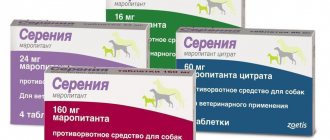A pet is a family member who lives in the same way day after day, sharing joys and sorrows with everyone. But the will of nature is such that everyone, both people and animals, is mortal. Owners have the power to make the painful end of life easier for their beloved pets through euthanasia. Literally, euthanasia is translated as a good death. It implies the approach of death by uninterested third parties for a sick patient. This third party is a veterinarian who must confirm the need for euthanasia, if so, and carry it out.
When is euthanasia necessary?
- Incurable diseases.
Dogs, cats and other pets can develop diseases that ultimately lead to a long and painful death for the animal. As a rule, these are cancers for which there is no treatment. In the final stages, the pet may experience severe suffering caused by the penetration of metastases into vital organs. The animal stops eating on its own, loses weight, and begins to choke.
In case of chronic renal failure in a dog or cat at the final stages of the disease, the kidney tissue degenerates into connective tissue, and the organ ceases to perform its function. The body is not cleansed of toxins, which remain in it and lead to slow poisoning, convulsions, coma and death.
- Uncontrolled aggressive behavior of an animal.
The burden of responsibility for such behavior falls entirely on the shoulders of the owner, because some breeds require special education. But in life-threatening situations, extreme measures may sometimes be necessary.
- Injuries incompatible with life.
It happens that dogs and cats get into accidents and are seriously injured. In cases where the prognosis is unfavorable and further treatment does not help, it is better to euthanize the animal so that it does not suffer from pain.
Indications for cat euthanasia
The grounds for euthanasia are usually:
- incurable diseases that cause suffering to the animal or significant impairment of body functions after illnesses;
- injuries incompatible with life;
- in some cases, the indication is old age.
As for injuries, there are many cases where seemingly hopeless animals that received multiple injuries and serious fractures, for example, having fallen under the wheels of a car, to the surprise of both the owners and the doctors, nevertheless recovered and continued a completely normal existence. No wonder there are sayings: “heals like a cat,” “a cat has two lives,” “tenacious like a cat.” So, you should never rush, and if the animal is dear to you, you need to give it a chance to recover by undergoing the necessary treatment.
In other cases, if the owner of the animal has doubts about whether to euthanize the animal or not, then you should not rely on the opinion of one veterinarian, but it is advisable to visit several specialists from different clinics and only if they are all unanimous that the treatment is not suitable. It makes sense to make the final decision.
After the decision to euthanize is made, the owner needs to prepare emotionally, choose a clinic and method of euthanasia, this is important both for the peace of mind of the owner himself and for an easier fate for the animal.
How does euthanasia of an animal occur?
- This procedure involves medically stopping the animal's heart and breathing. Humane euthanasia occurs in two stages. At the first stage, the animal is put into deep anesthesia using an injection. At this stage, the presence of hosts is allowed. The effect of anesthesia begins a few minutes after the injection. Then the doctor makes sure that the anesthetic drugs have worked properly, this happens after 10-15 minutes. After this, the owners say goodbye to their pet.
- At the second stage, the doctor injects the animal with drugs that stop breathing and cardiac activity. Before the second injection, the animal’s consciousness must be completely turned off. The doctor gives an intravenous injection, and after 5, 10 and 15 minutes he makes sure that there are no reflexes, heartbeat and breathing. Then he is pronounced dead.
Preparations for euthanasia
American doctors, for euthanasia, use the drug “Euthanasin”, in Germany the drug “T-61”, which first “turns off consciousness”, after which they cause respiratory arrest and paralyze the heart muscle.
In our country, these drugs are prohibited; lethal doses of drugs are used for euthanasia:
- sedatives (xylazine);
- anesthetics (propofol, droperidol, sodium etaminal, sodium thiopental);
- muscle relaxants (arduan, ditilene);
- electrolytes (magnesium sulfate);
- antiarrhythmic (lidocaine).
Possible euthanasia schemes:
- Euthanasia using lethal doses of the above anesthetics. With this method, the animal falls asleep, there are no convulsions or agony, after some time breathing stops and then cardiac arrest occurs. Difficulties may arise due to the fact that these drugs are administered strictly intravenously, and with many diseases and serious conditions of the animal, intravenous administration can be difficult. Additionally, these drugs are not legally available to veterinarians. If the first method is not possible, use the second scheme.
- The usual intramuscular anesthesia is first administered, for example Rometar + Zoletil, and after losing consciousness, a drug for euthanasia is administered: Lidocaine, Magnesium sulfate, Ditilin.
These two methods ensure that the animal does not suffer in any way during the euthanasia process.
It is important for the pet owner to know:
- Euthanasia with Ditilin is carried out after the cat is put into a state of deep anesthesia. Otherwise, Ditilin causes painful death from suffocation, and, all this time, the animal is conscious;
- Magnesium sulfate – the use of magnesium sulfate accompanies the development of vascular spasm and subsequently paralyzes the respiratory center, resulting in respiratory arrest and death. Should also be used after anesthesia;
- Lidocaine is a strong local anesthetic and a drug that affects the automatism of the cardiac sinus node and the conductivity of the heart muscle. During euthanasia, lidocaine causes bradycardia and cardiac arrest. Before administering the drug, the animal must be anesthetized.
What kind of euthanasia should not happen?
Many people, including veterinarians, oppose euthanasia. But here it is necessary to clarify what exactly the procedure is being discussed against. Unfortunately, sometimes the animal is immediately injected with drugs to stop pulmonary and cardiac activity, without prior anesthesia. Any conscientious doctor will be against this and will not even offer this option. After all, the animal is fully conscious and dies from the inability to take a breath, it simply suffocates and dies from suffocation, suffering incredibly. The majority of understanding people are against such euthanasia, without prior deep anesthesia.
It should also be alarming if the veterinarian immediately suggests euthanizing an animal that was brought to the appointment, without properly examining it or even trying to prescribe treatment. The owners should be against this approach. But such cases are rare. It often happens that, on the contrary, veterinarians take away from the owners the animal that the owners brought to be euthanized and nurse it.
How does an animal feel when euthanized?
Putting a beloved animal to sleep is a painful moment for the owner. Many people cannot decide to euthanasia for fear that this manipulation will cause the animal even greater suffering than it already experiences due to illness or injury. But due to ignorance, such a person does exactly what he does not want - namely, makes the animal feel pain, while euthanasia is designed to relieve this suffering, quickly and humanely.
Let's figure out what exactly an animal feels when being euthanized, and why you can be sure that it does not feel pain, suffocation or other discomfort.
It is important to understand that the animal does not experience mental anguish either before or, especially during euthanasia. Owners tend to endow their pets with their own pain, transfer their own feelings onto them, imagine what they themselves would feel and think about if they were awaiting euthanasia. However, this is a misguided tendency. Animals lack a second signaling system, so they cannot have reflections. The only things that are the same for everyone are physical pain, suffocation and other physical suffering. For a sick animal there are no thoughts about a possible future, it is not tormented by separation, and is not afraid of moving to another world. But the animal is in pain here and now, and it wants it to stop, although it cannot express it in words. Thus, BEFORE being put to sleep, it only feels physical agony.
Naturally, the animal is in deep stress just because of the very fact of the ongoing pain that it experiences. An animal may feel fear of a stranger - a veterinarian, and even more so of a clinic where it smells of other animals and their fears. In order to cope with these problems, it is advisable to carry out the euthanasia procedure at home . Firstly, the pet will be calmer in a familiar environment. Secondly, the owner will be able to calm him down during the process of meeting the veterinarian. The best option for euthanasia for a pet, which will make its care as easy as possible, is to be nearby during the procedure and speak kind words to the animal until the moment the specialist puts it under anesthesia.
And now about what pets feel directly when euthanized.
The purpose of euthanizing an animal is to humanely relieve it of suffering, and not to cause it. That is why the first of the two stages that the euthanasia process includes is putting the animal under anesthesia. Animals are given the same anesthesia during surgical operations. It affects the central nervous system and suppresses pain nerve impulses. Pain receptors turn off. The animal falls into deep sleep, immediately ceasing to suffer.
Using special manipulations, the veterinarian makes sure that the anesthesia has worked, and only then begins the second stage of euthanasia. The animal is given a drug that stops the heart and breathing. The sick animal does not experience any pain or discomfort. In addition, after the first stage of euthanasia is completed, we can confidently say that the animal does not hear you or feel your touch.
It happens that during euthanasia, involuntary muscle contractions of the animal occur, there may be convulsions and/or sharp inhalations and exhalations. But all these phenomena are purely reflexive in nature; the animal does not feel anything in this case either.
In general, the procedure for euthanizing an animal takes about 20 minutes.
Under no circumstances should you euthanize an animal yourself. There is a lot of information and valuable advice on the Internet, but those who give it are not always competent enough. Unfortunately, they are often handed out by people without veterinary education and without understanding the patterns of functioning of the body of either a sick or even a healthy animal. Therefore, if you decide to euthanize an animal , be sure to invite a veterinarian from the clinic. A certified practicing veterinarian has access to and approval for specialized medications that will allow euthanasia to occur painlessly and quickly. In addition, he knows exactly which areas should be injected during euthanasia - and this is also of great importance. You don’t invite a chef to fix complex equipment in your home when it breaks. And you are unlikely to do it yourself. And the animal’s body is a much more complex and subtle matter than even the “brain” of the most sophisticated and “smart” technology. Therefore, let a specialist in the field of just such complex organisms deal with this complex organism.
Thus, during euthanasia, carried out according to all the rules by a specialist, the animal does not feel pain, suffocation, convulsions or other physical discomfort. The animal also does not feel moral torment and does not suffer about its transition to another world, it will only experience relief that its physical torment has stopped.
During euthanasia, the pet will feel calmer and more confident in a familiar place, that is, at home, and hearing the owner’s voice, feeling his presence - exactly until the moment when the anesthesia takes effect. After the anesthesia has taken effect, the animal will not feel anything.
How the owner feels during all of the above processes is a separate topic. However, I would like to emphasize that in a situation where an animal is suffering, it is more important to think about the animal, about its comfort, about bringing relief first of all to it. And the owner must temporarily put aside his own feelings and doubts.
Euthanasia at home
Euthanasia of animals at home, especially euthanasia of a cat, is justified. Drugs for euthanasia are allowed to be injected at home. Then the animal will not have to experience additional stress associated with a trip to the clinic. The pet will spend the last hours in a familiar and calm environment and surrounded by loved ones who will be with him until the very end.
Before the procedure, the animal must be placed on a disposable absorbent diaper; after the administration of anesthesia, vomiting and then involuntary urination or defecation are possible.
But not all clinics provide such a service. This is associated with a certain risk, because it is not clear how the animal will ultimately behave. That's why some people oppose euthanasia at home. Whether the procedure should be carried out at home or in a clinic is up to the owners to decide.
What is euthanasia
Euthanasia or euthanasia is the introduction of a lethal dose of a drug into the body. In some countries, even the euthanasia of people is considered legal. The procedure is carried out with the consent of the patient, for medical reasons, if the person has confirmed his intention three times within six months. Euthanasia is also a type of death penalty.
The world views the euthanasia of animals much more simply. Moreover, literally every year, at major medical conferences concerning incurable diseases, world medical leaders raise the question of the humanity of euthanasia. During the lectures there are constant references to veterinary medicine, which is perceived with hostility by conservatives.
Service cost
There is no exact answer to the question of how much it costs to euthanize a cat or dog. The price list differs depending on the weight of the animal, the type of drug and the clinic itself. The price varies from 1000 to 3500 rubles. How much it costs to euthanize a dog or cat at home is more difficult to answer. Most likely, the price will be negotiable.
Sometimes we are powerless to fix things. Then you need to accept the situation and find the strength to be with your beloved friend to the end, not prolonging his torment, but allowing him in a dream to go to the land of a good hunt on the rainbow. Health and long life to you and your pets!
Republished by Blog Post Promoter
WE ADVISE YOU TO READ:
Registration of consent to vaccination or refusal of it
Previous article
Vaccination against whooping cough, diphtheria and tetanus
Next article
Discussion: there is 1 comment
- Kirill:
05/05/2020 at 14:52Euthanasia of animals is best done at home, in my opinion. Otherwise, the poor pet will experience even more stress at such a difficult time for him. At least that’s what MosvetCenter specialists told me mosvetcenter.ru If there are no contraindications for carrying out this procedure at home, they recommend this.
The question of humanity: pros and cons
Living for many years together with his smaller brothers, a person tends to experience a strong sense of affection for his pet, which often becomes a full member of the family, and for a lonely person, sometimes the only friend.
It is clear that if an animal experiences pain from which it is not possible to relieve it, the owner also experiences suffering from the awareness of his helplessness, and this is probably the only case when the decision to euthanasia is justified from a moral point of view.
But, in addition to unbearable suffering, there are many other reasons when the owner of an animal decides to euthanize the animal and not always for this, there is a good reason, in these cases it would be good to remember, “we are responsible for those we have tamed” and instead of killing, try place the animal if it becomes uncomfortable.
There are also many diseases, including those related to the age of the cat, when the veterinarian may suggest euthanasia to the owner.
Since the euthanasia procedure for animals is not regulated in any way in our country, that is, any animal owner has the right to make such a decision, regardless of the reasons, whether the animal is sick or there are less serious reasons for this, then making a decision on euthanasia is a matter conscience, personal beliefs and simply the strength of emotional attachment of the owner of a cat or dog.
The Church has different opinions on the issue of euthanasia of animals, some church ministers consider it unacceptable, as well as the use of euthanasia in relation to humans, others believe that a person has the right to dispose of the life of an animal, in cases where the animal suffers and when, in order to treat the animal, a person has to deprive your family of a lot.
Euthanasia of animals in the clinic: procedure for carrying out the procedure
Of course, no one will simply euthanize a cat, dog or other pet for its owner. Euthanasia of animals is carried out after a thorough examination of the pet and only when it is impossible to help with other methods. The procedure in this case is as follows:
- examination by a veterinarian, after which the doctor gives an opinion with a recommendation for euthanasia;
- signing the written consent of the owner to carry out the procedure; at this stage, you can also immediately decide on the disposal of the body (independent organization of cremation or funeral or by the clinic);
- carrying out the procedure;
- removal of the body.
The procedure itself lasts no more than 20 minutes. The owner is allowed to be near the animal until it is put to sleep. As soon as the pet falls asleep, you should leave. This is due to the fact that euthanasia of cats and dogs is a difficult procedure for the animal owner and can cause psychological trauma.
Just a couple more words about the inspection. To exclude medical error, we recommend that you undergo examination by several veterinarians. Sometimes it happens that one doctor prescribes euthanasia, and another knows how to cure the disease and prolong the life of the pet.
Believe me, the life of your four-legged friend is worth fighting for and visiting several doctors. After all, he has completely dedicated this life to you. Treat this with respect.
Let go to the rainbow
The decision to euthanize a dog, cat or other pet is always very difficult and requires some determination from the owners. Looking at the torment of a loved one, knowing that it is no longer possible to help, is extremely difficult. You need to think about the fact that a faithful friend deserves to make his death easier. Modern drugs allow you to do this as painlessly as possible for your pet. It would be best to listen to the opinions of several specialists who will examine the pet.
Some people are fundamentally against euthanasia. But humane euthanasia allows the animal to pass away with dignity, without suffering or pain. Not deciding to take the last step and waiting for a natural death is sometimes very selfish in relation to the pet. You need to try to make a difficult decision and let go of your dear friend with love.
Where is it held?
The procedure for euthanizing a cat can only be carried out by a veterinarian. But the owner has the choice of the location: in the clinic or at home. From the point of view of animal psychology, it is better to do this at home, in the conditions familiar to the cat, where she spent most or all of her life.
The additional journey to the clinic can cause stress and add to the anguish of the last moments of life. But if the cat has often been to the clinic for preventive examinations or vaccinations and knows the doctor well, it can go there too. The fact is that for some owners, euthanasia at home can cause a certain emotional blow, and after the procedure, the place in which it will be carried out will become associated with the loss of their pet.
Each owner must analyze all psychological aspects and choose a place where euthanasia is least likely to traumatize his pet and himself.
ATTENTION! It is forbidden to euthanize an animal yourself, even if you buy special medications. This can only increase his suffering.











